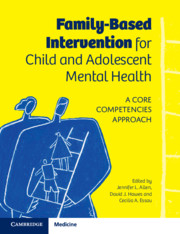Book contents
- Family-Based Intervention for Child and Adolescent Mental Health
- Family-Based Intervention for Child and Adolescent Mental Health
- Copyright page
- Contents
- Contributors
- Preface
- Part I Theoretical Perspectives on Family-Based Intervention
- Part II Core Clinical Competencies
- Part III Family Intervention for Specific Child and Adolescent Mental Health Problems
- Part IV Family Intervention for Children at Risk Due to Family Dysfunction or Past Adversity
- Chapter 16 Working with Parents with Depression in Family Intervention
- Chapter 17 Working with Parents with Anxiety in Family Intervention
- Chapter 18 Working with Families of Children Who Have Experienced Maltreatment
- Chapter 19 Working with Families and Children Exposed to Intimate Partner Violence
- Part V New Developments in Family-Based Intervention
- Index
- References
Chapter 16 - Working with Parents with Depression in Family Intervention
from Part IV - Family Intervention for Children at Risk Due to Family Dysfunction or Past Adversity
Published online by Cambridge University Press: 18 February 2021
- Family-Based Intervention for Child and Adolescent Mental Health
- Family-Based Intervention for Child and Adolescent Mental Health
- Copyright page
- Contents
- Contributors
- Preface
- Part I Theoretical Perspectives on Family-Based Intervention
- Part II Core Clinical Competencies
- Part III Family Intervention for Specific Child and Adolescent Mental Health Problems
- Part IV Family Intervention for Children at Risk Due to Family Dysfunction or Past Adversity
- Chapter 16 Working with Parents with Depression in Family Intervention
- Chapter 17 Working with Parents with Anxiety in Family Intervention
- Chapter 18 Working with Families of Children Who Have Experienced Maltreatment
- Chapter 19 Working with Families and Children Exposed to Intimate Partner Violence
- Part V New Developments in Family-Based Intervention
- Index
- References
Summary
Parental depression is associated with maladaptive cognitive, academic, socio-emotional and psychological outcomes in offspring. Children with a depressed parent are three to four times more likely to be diagnosed with depression than children with non-depressed parents, making parental depression a significant risk factor in the onset of childhood depression. Preventive interventions aim to reduce the likelihood that depressive symptoms will onset by decreasing risk factors and increasing protective factors. In family-based preventive interventions for children who are at risk for depression due to parental depressive symptoms, clinicians aim to build resilience in children by addressing risk and protective factors. Such intervention programs have been shown to effectively reduce depressive symptoms in children. This chapter summarizes the effects of parental depression on children, risk and protective factors associated with resilience and the family-based preventive interventions used to mitigate the effects of parental depression on children and presents an example case study highlighting one of these preventive interventions. Finally, the chapter reviews essential clinical competencies for productive work in family-based depression preventive interventions.
Keywords
- Type
- Chapter
- Information
- Family-Based Intervention for Child and Adolescent Mental HealthA Core Competencies Approach, pp. 207 - 224Publisher: Cambridge University PressPrint publication year: 2021

